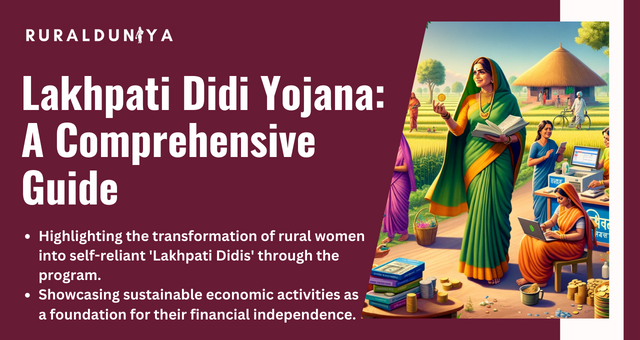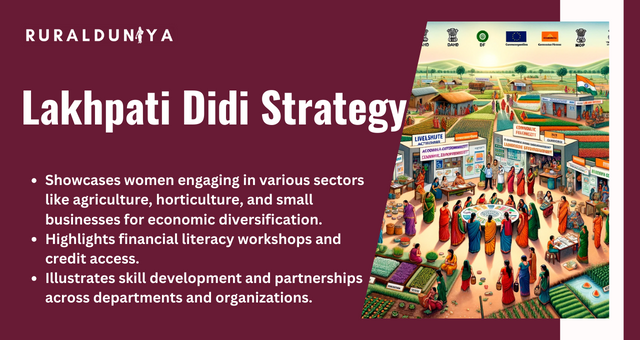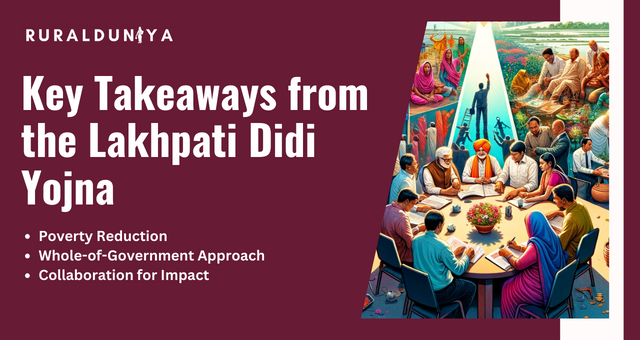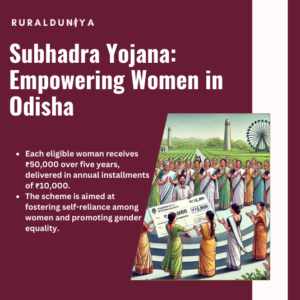Have you heard about the Lakhpati Didi Yojana? It is a flagship poverty alleviation program implemented by the Ministry of Rural Development, Government of India, under the Deendayal Antyodaya Yojana – National Rural Livelihoods Mission (DAY-NRLM).
Aimed at enabling 3 Crore ‘LAKHPATI DIDIs’ – SHG Didis who earn a sustainable income of at least Rs One Lakh per annum per Household.
What is Lakhpati Didi Yojana (Scheme)? : Know Everything

The ambitious goal was announced by the Prime Minister from the ramparts of the Red Fort on Lakhpati Didi on August 15, 2023, in his Independence Day address. He said, “Today, 10 crore Rural Women are part of the Self-Help Groups.
When you go to a village, you will find ‘Bank-wali didi,’ ‘Anganwadi didi,’ and ‘Dawai-wali (medicine) didi.’ It is my dream to make three crore Lakhpati didis in the villages.
The Ministry of Rural Development, Government of India, has initiated the Lakhpati Didi program with the objective of stimulating financial autonomy and economic empowerment among women residing in rural regions.
A member of the Self-Help Group who attains or exceeds an annual household income of One Lakh Rupees (₹1,00,000) is referred to as a Lakhpati Didi.
In order to ensure sustainability, this income is computed over a minimum of four agricultural seasons and/or business cycles, and its average monthly revenue surpasses ten thousand rupees (₹10,000).
Lakhpati Didi Yojana Budget 2024-25
Extending the Yojana was announced by Union Finance Minister Nirmala Sitharaman in her Interim Budget 2024-25 speech, in keeping with Prime Minister Narendra Modi’s goal of empowering two crore women entrepreneurs in rural areas.
Sitharaman added that the number of beneficiaries will be increased to three crore in the interim budget, highlighting the self-reliance and empowerment that approximately one crore rural women have acquired via the plan so far.
In her budget statement, the finance minister announced an increase to the aim for Lakhpati Didi from 2 crore to 3 crore, reflecting on the accomplishments as an example to others and the decision to reward them.
Aim of Lakhpati Didi Yojana

- Universal coverage of SHG households for livelihood activities and enabling sustainable income (Aspirational income of approximately INR 1 lakh per annum).
- Strengthening the CLFs to anchor all livelihood processes and systems.
Lakhpati Didi Yojana How to Apply
- Active participation in Self Help Groups (SHGs) is mandatory.
- SHG membership is a prerequisite.
- Communication initiation with Block Mission Management Unit or Cluster Level Federation is encouraged.
Lakhpati Didi Portal, Scheme Eligibility and Form
- Inauguration:
- The ‘Lakhpati Didi Web Portal‘ was inaugurated by Shri Shailesh Kumar Singh, Secretary RD.
- It serves as an all-encompassing informational hub for the flagship initiative empowering Didis.
- Application Procedure:
- Self-help group membership is mandatory.
- Interested women can reach out to the Cluster Level Federation for additional information.
- Enrollment Requirements:
- Submission of pertinent documentation is necessary.
- Data collection from the Community Resource Person of Lakhpati Didi is part of the enrollment process.
Benefits of Lakhpati Didi Scheme

The quality of life experiences of poor communities suffer due to inequitable access to markets as both producers and consumers of goods and services.
As producers of goods and services, the poor community lacks access to market linkages that offer remunerative prices and quality rewards, both in the input and output markets.
As a result, the poor are often trapped in a vicious cycle of low investment and low returns in production opportunities, making it difficult for them to emerge from poverty.
One way to tackle such challenges is through collective action, which bridges the gap between the poor and the market.
Therefore, federations of SHG women can emerge as one of the more effective mechanisms to address challenges faced by their members, such as access to markets, credit, technology, and information.
Lakhpati Didi Strategy

i. Diversification of Livelihood Activities: Support members in diversifying interventions across the farm, non-farm, and service sectors.
To enhance income, households may be encouraged to take up multiple activities such as agriculture, high-value agriculture, horticulture, livestock, fisheries, NTFP (Non-Timber Forest Products), and small enterprise activities.
ii. Increase Access to Finance/Credit: SHG and federations are made financially literate, and CLFs are empowered to provide adequate and timely credit linkages, facilitating access to the requisite amount of credit/bank finance for undertaking livelihood activities.
iii. Skilling of the Community Cadre/CLF-VO-SHGs: To help SHG members prepare livelihood plans and engage in livelihood activities, and to participate in value chain interventions.
iv. Convergence and Partnership: The key to the success of this strategy lies in the convergence of all resources available at the village or Gram Panchayat level. Convergence can be both intradepartmental and interdepartmental.
Convergence efforts have been initiated with the schemes of Department of Agriculture Cooperation and Farmers Welfare (DAC&FW), Department of Animal Husbandry, Dairying (DAHD), Department of Fisheries (DoF), Tribal Cooperative Marketing Federation of India (TRIFED), Ministry of Food Processing and Industries (MoFPI), and Ministry of Panchayati Raj (MoPR).
How Lakhpati Didi Initiative Works?
The platform of women collectives, as the frontline community organization, has allowed for the convergence of all rural-focused programs.
To ensure this, livelihood planning has been carried out for each household, supporting the necessary backward and forward linkages.
The Village Prosperity and Resilience Planning (VPRP) has strengthened the Gram Panchayat Development Plan, which has emerged as the primary planning platform in rural areas.
The strategy includes focused planning at the district level, providing adequate and timely support to the household level, building convergence and partnerships to leverage more for the initiative, and capacity building of staff, community institutions, and community resource persons.
It also involves the identification of livelihood options that are feasible within the resource matrix of the particular district.
Key Takeaways

Lakhpati Didi Yojna helps in reduce poverty by enabling poor households to access gainful self-employment and skilled-wage employment opportunities, resulting in sustainable and diversified livelihood options for the poor.
To maximize impact through convergence and transform the rural economy by enabling ‘Lakhpati Didis,’ it is crucial to adopt a Whole-of-Government Approach, ensuring convergent efforts both intra and interdepartmentally.
Government, PRI (Panchayati Raj Institutions), and CBOs (Community-Based Organizations) must work together and supplement each other to extend the benefits to the rural poor.
FAQs
Who launched Lakhpati Didi Yojana?
This Yojana was launched by Prime Minister Shri Narendra Modi
When was Lakhpati Didi scheme launched?
Scheme was launched on August 15, 2023
Which ministry is under Lakhpati Didi Scheme?
This Scheme is under the Ministry of Rural Development, Government of India.
What is the budget of Lakhpati Didi?
In presenting the interim budget, Union Finance Minister Nirmala Sitharaman declared that the ‘Lakhpati Didi’ initiative would expand its target population from two crore women to three crore women. Lakhpati Didis are self-help group didis (SHGs) that generate a minimum annual sustainable income of one Lakh per household.
Which state started Lakhpati Didi Yojana?
The Lakhpati Didi Scheme was implemented in Rajasthan on December 23, 2023.

Nishank is a social impact enthusiast with a solid foundation in public policy, micro-enterprise, and agribusiness. Growing up in a farmer’s family has given him a profound connection to rural communities, fueling his passion to empower people towards self-reliance. He completed his undergraduate studies at the Delhi University and earned a master’s degree in Rural Management from National Institute of Rural Development & Panchayati Raj in Hyderabad.



